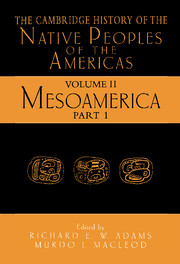Book contents
- Frontmatter
- Contents
- List of Illustrations
- Part I
- 1 Introduction to a Survey of the Native Prehistoric Cultures of Mesoamerica
- 2 The Paleoindian and Archaic Cultures of Mesoamerica
- 3 The Preclassic Societies of the Central Highlands of Mesoamerica
- 4 The Precolumbian Cultures of the Gulf Coast
- 5 The Maya Lowlands: Pioneer Farmers to Merchant Princes
- 6 The Central Mexican Highlands from the Rise of Teotihuacan to the Decline of Tula
- 7 Western and Northwestern Mexico
- 8 Cultural Evolution in Oaxaca: The Origins of the Zapotec and Mixtec Civilizations
- 9 The Southeast Frontiers of Mesoamerica
- 10 The Maya Highlands and the Adjacent Pacific Coast
- 11 The Aztecs and Their Contemporaries: The Central and Eastern Mexican Highlands
- Index
10 - The Maya Highlands and the Adjacent Pacific Coast
Published online by Cambridge University Press: 28 March 2008
- Frontmatter
- Contents
- List of Illustrations
- Part I
- 1 Introduction to a Survey of the Native Prehistoric Cultures of Mesoamerica
- 2 The Paleoindian and Archaic Cultures of Mesoamerica
- 3 The Preclassic Societies of the Central Highlands of Mesoamerica
- 4 The Precolumbian Cultures of the Gulf Coast
- 5 The Maya Lowlands: Pioneer Farmers to Merchant Princes
- 6 The Central Mexican Highlands from the Rise of Teotihuacan to the Decline of Tula
- 7 Western and Northwestern Mexico
- 8 Cultural Evolution in Oaxaca: The Origins of the Zapotec and Mixtec Civilizations
- 9 The Southeast Frontiers of Mesoamerica
- 10 The Maya Highlands and the Adjacent Pacific Coast
- 11 The Aztecs and Their Contemporaries: The Central and Eastern Mexican Highlands
- Index
Summary
INTRODUCTION
In this chapter we refer to the Maya highlands and Pacific coastal plain collectively as the southern Maya Area (see Map IO.I). We follow the chronological framework most commonly used by Mesoamerican scholars, beginning with the Preclassic era (c. 2000 B.C. to A.D. 250; for earlier developments, see Zeitland and Zeitland, Chap. 2, this volume), subdivided into the Early Preclassic (c. 2000–1000 B.C.), Middle Preclassic (c. 1000–400 B.C.), and Late Preclassic (c. 400 B.C.–A.D. 100); a transitional Terminal Preclassic (c. A.D. 100–250), the subsequent Classic period (c. A.D. 250–800), subdivided into two eras, the Early Classic (c. A.D. 250–600), and Late Classic (c. A.D. 600–800); and ending with the Postclassic (c. A.D. 900–1500), subdivided into the Early Postclassic (c. 900–1200) and Late Postclassic (c. 1200–1500).
Archaeological research in the southern Maya Area has long lagged behind that conducted in the Maya lowlands to the north. Over the past two decades, however, research and publications dealing with the southern area have begun to correct this disparity. Nonetheless, spatial and temporal coverage remains inconsistent. Most of the work on the Early and Middle Preclassic has been concentrated along the Pacific Coast (especially in the western sector). Research on the Late Preclassic period has received more attention, and there is a broader coverage, most notably focusing on the regional developments in the southern highlands (especially Kaminaljuyu), the southeast, and along the Pacific coastal plain. For the Classic era most of our knowledge is based on work at Kaminaljuyu and adjacent basins of the southern highlands, and the central region of the Pacific coastal plain. Archaeological research on the Postclassic era has focused on sites and regions associated with the Con quest-era highland states, with varying reliance on the rich but often contradictory ethnohistoric sources that illuminate this period. Overall, therefore, inconsistent coverage makes any synthesis unbalanced and provisional at best.
ENVIRONMENT
The Pacific plain is composed of recent (quaternary) sediments extending from the Isthmus of Tehuantepec, across southern Chiapas (Mexico), through Guatemala, and into western El Salvador. It has long provided rich resources for human existence and has been an avenue for both migration and commerce. Some of the earliest traces of permanent settlement in Mesoamerica have been found along the margins of the mangrove swamps, coastal lagoons, and meandering river mouths that lie behind the Pacific beaches.
- Type
- Chapter
- Information
- The Cambridge History of the Native Peoples of the Americas , pp. 449 - 499Publisher: Cambridge University PressPrint publication year: 2000
- 3
- Cited by



